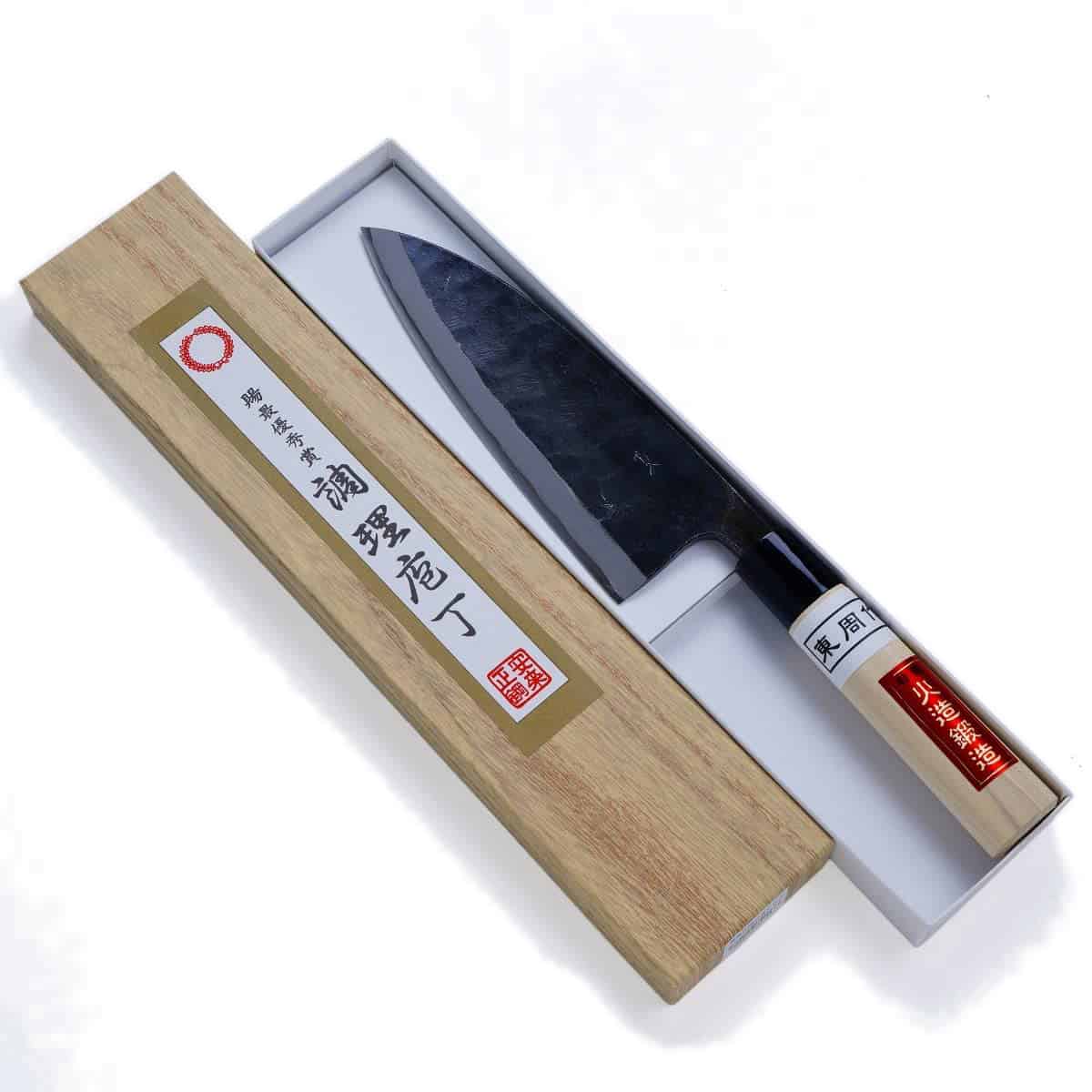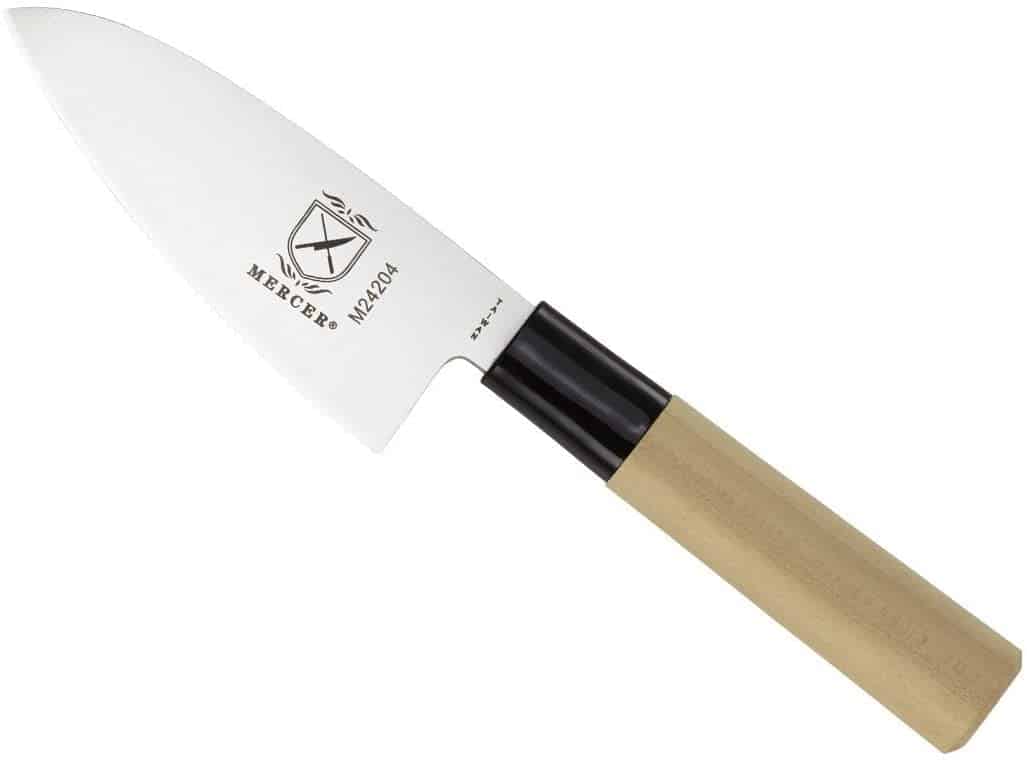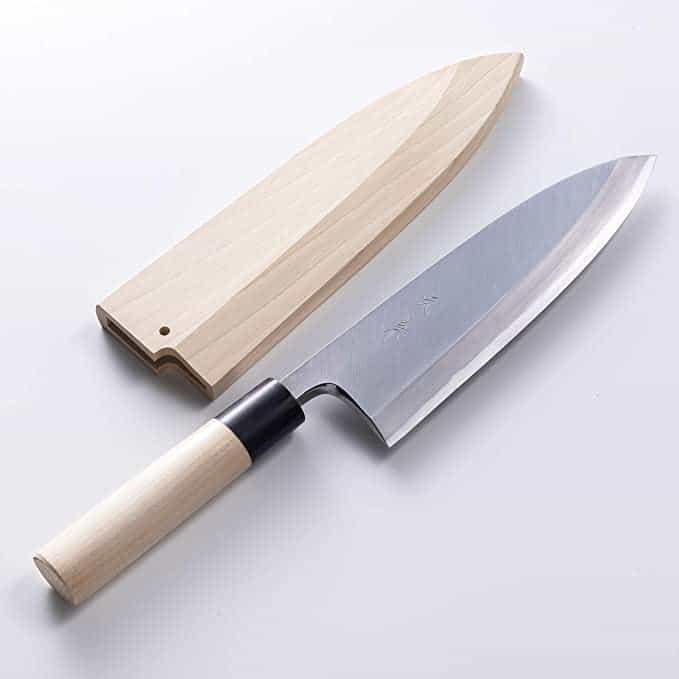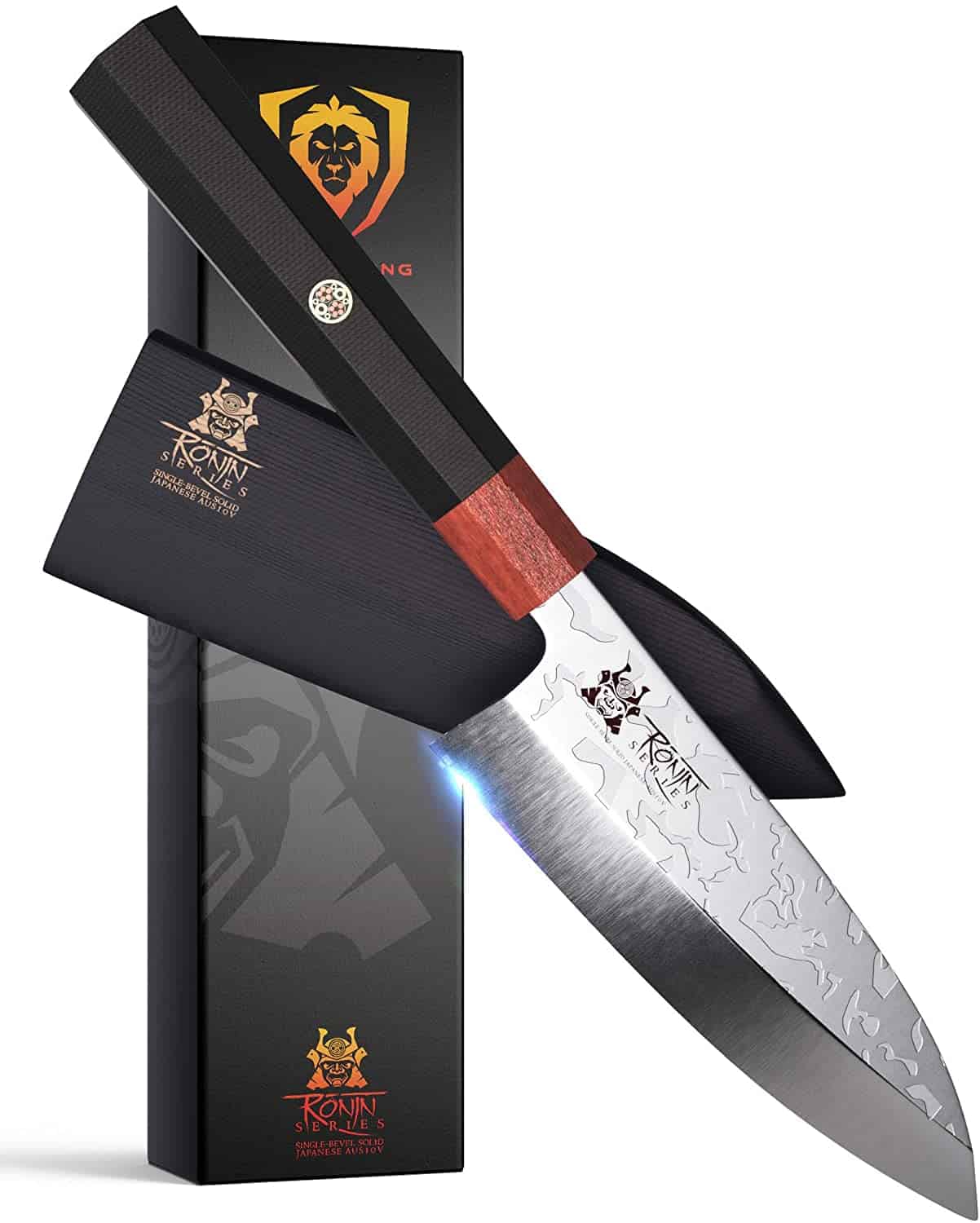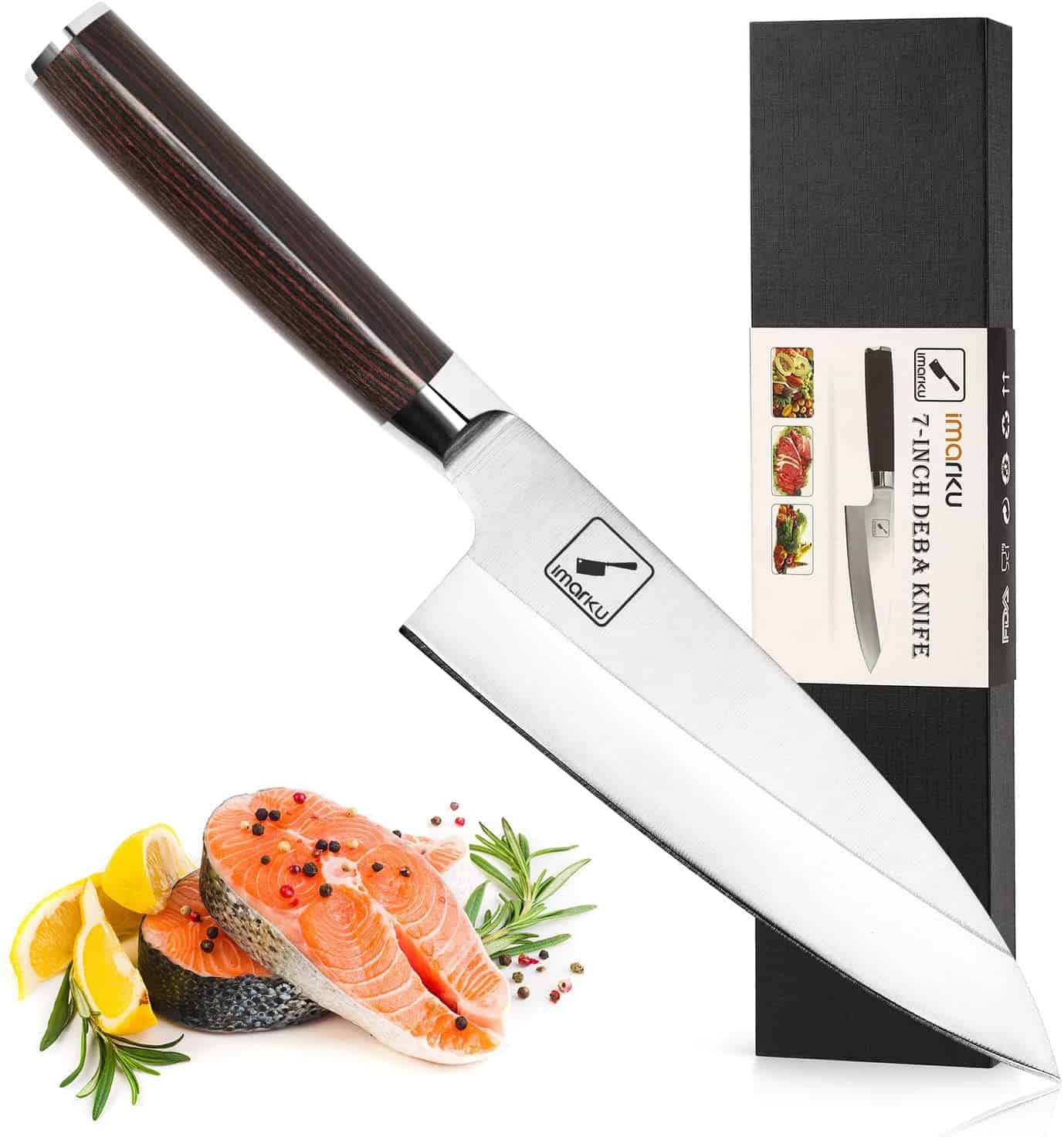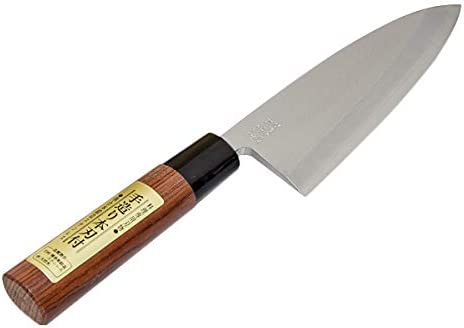6 Best Japanese Deba Knives For Cutting Fish And Bones
If you love preparing Japanese fish dishes like sushi and sashimi, you need a deba knife in your kitchen.
This AZUMASYUSAKU” Deba Hocho has a double-bevel blade, so it’s easier to use for both lefties and righties. It can cut through fish heads, slice bigger fish and create perfect fillets. This knife is made by Japanese craftsmen for all your fish cooking needs.
But there are more options. If you’re looking for a versatile Japanese knife that can handle both delicate and tough cuts of fish, this is the buying guide for you!
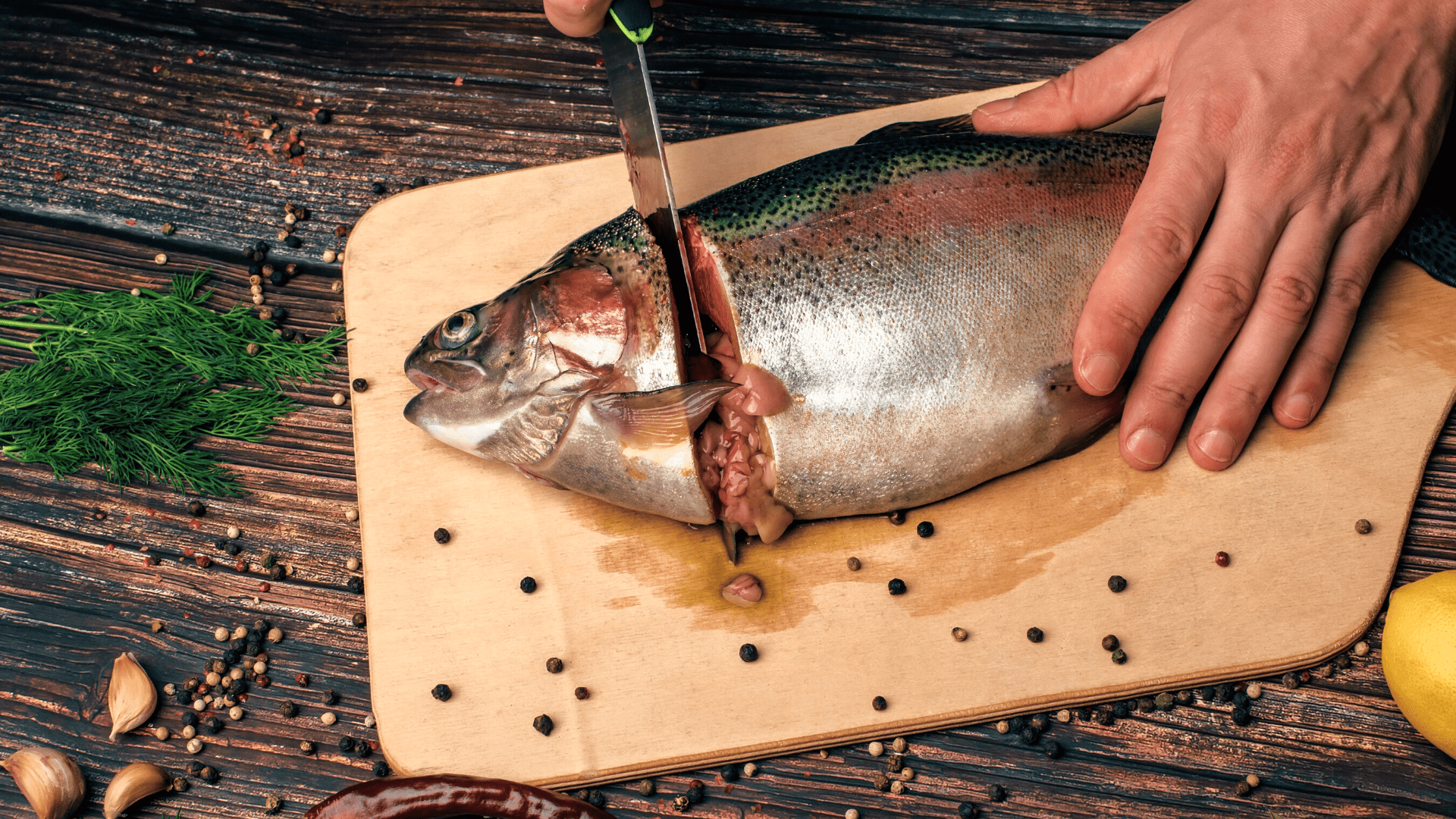
Check out our top picks for the best deba knives in this table, then keep reading to see the full reviews below.
Best overall deba knife
Combines the best of two worlds: the sharpness of a Japanese knife and the European-style double-edge that’s easy to use when cooking fish.
Best budget deba knife
The Mercer is the top pick if you’re a home cook looking for a good beginner-friendly and budget-friendly deba knife.
Best handmade deba knife
If you’re looking for the perfect traditional deba knife made by Japanese craftsmen, you need to add Motokane deba to your collection. This is the knife for serious fish cooking.
Best Damascus steel deba
Dalstrong has become one of the fastest-growing Japanese knife makers because they use Damascus steel to forge their blades.
Best value deba knife
Since it has a single bevel sharpened to 12-15°, it has a smooth blade that will fillet the fish without any kind of tears in the flesh.
Best large deba knife
The Honnamon Mioroshi deba is the best multi-purpose knife because it has a durable blade and sharper edge than cheaper knives.

Check out our new cookbook
Bitemybun's family recipes with complete meal planner and recipe guide.
Try it out for free with Kindle Unlimited:
Read for freeIn this post we'll cover:
Deba Knife Buying guide
If you’re looking to buy a deba knife, there are a few things you need to consider. First, you need to decide what type of fish you’ll be preparing.
Debas come in different shapes and sizes, so you need to find one suitable for the type of fish you’re cooking. You also need to consider the size of the knife.
Some debas are smaller than others, so you need to ensure you get one that is the right size for your needs. Finally, you need to think about the price.
Deba knives can range in price from a few dollars to hundreds of dollars. You need to find one that is within your budget.
A deba knife is an essential tool for making sushi and sashimi. If you’re looking to buy one, there are a few things you need to consider.
First, you need to decide what type of fish you’ll be preparing.
These are the features to look for:
Size
Yes, deba knives come in different sizes to accommodate different types of fish. The most common sizes are 150mm, 165mm, 180mm, and 210mm.
Size, in this case, usually refers to blade length.
The size you need will depend on the type of fish you’re cutting.
For example, a 165mm knife would be too small for cutting a tuna steak, but it would be just the right size for filleting a small fish like a flounder.
Deba knife thickness
The thickness of the blade is also an important consideration. The thicker the blade, the tougher the fish it can handle.
A thicker blade is also less likely to flex when cutting through tough fish bones. However, a thicker blade can be more difficult to sharpen than a thinner one.
The most common thicknesses are 2.5mm, 3.0mm, and 3.5mm.
Bevel
The bevel is the angle of the blade’s edge. The most common bevels for deba knives are 50/50 and 70/30.
A 50/50 bevel means that the blade is equally sharp on both sides. This type of knife is best for filleting fish because it produces very thin, even slices.
A 70/30 bevel means that the blade is sharpened more on one side than the other. This type of knife is better for sushi and sashimi preparation because it produces thicker slices.
Double-bevel knives are pretty standard, which means that the blade is sharpened on both sides at different angles. These knives are more versatile, but they’re also more expensive.
Single-bevel blades are only sharpened on one side. They’re more challenging to use, but they produce very thin, precise slices.
Material
The best materials for a deba knife are high-carbon steel and stainless steel.
High-carbon steel is the traditional choice for Japanese knives. It’s easy to sharpen and holds an edge well, but it’s susceptible to rust and corrosion.
Stainless steel is a more modern option that is less likely to rust, but it can be more difficult to sharpen.
Some deba knives are made with a laminated construction, where the blade is made of multiple layers of different materials. This construction is designed to combine the best attributes of both high-carbon steel and stainless steel.
Laminated blades are less likely to rust than those made of high-carbon steel, but they’re still easy to sharpen.
Handle
Most deba knives have a Western-style handle made of wood, plastic, or composite material.
Some models have a Japanese-style handle called a D-shaped handle. This type of handle is more comfortable for those who prefer to hold the knife in their palm.
The most common handle material is natural wood, but it’s harder to clean.
The second is Pakkawood, a composite of wood and plastic. Pakkawood is durable and easy to care for, making it a good choice for busy kitchens.
Edge angle
The edge angle of a deba knife is the angle between the blade and the cutting edge.
The most common edge angles are 50 degrees and 60 degrees. Most are sharpened to a 45-degree angle.
Weight and balance
The weight and balance of a deba knife are also important considerations. A heavier knife will be more comfortable but can be tiring to hold for long periods.
A lighter knife is easier to handle but can feel flimsy when cutting through tough fish bones.
The balance of the knife is determined by where the blade meets the handle. A well-balanced knife will feel comfortable in your hand and be easy to control.
Blade shape
Deba knives have a unique blade shape that sets them apart from other types of Japanese knives. The blade is broad and curves inward toward the tip, with a blunt end.
This design gives the knife extra strength and makes it ideal for cutting through fish bones.
Full-tang construction
A full-tang knife has a blade that extends all the way to the end of the handle. This type of construction is more durable and provides a better balance than a partial tang.
When choosing a deba knife, look for one with full-tang construction.
Best 6 deba knives reviewed
Now that you know what to look for in a deba knife check out our top picks.
AZUMASYUSAKU Aogami Steel
- Ultra sharp high-carbon steel and has a double-bevel blade
- Large 7.1 inch blade
- Authentic wooden D-shaped handle
- High maintenance aogami steel
- size: 7.1 inches
- material: aogami steel
- bevel: double
- handle: wood
- weight: 12.7 oz
A really good deba knife is never too cheap, and investing in a high-quality one will make all the difference between easy cutting work and a struggle to cut up fish.
Azumasyusaku is a traditional deba knife that is made in Japan by Tosa artisans. The knife is made of high-carbon steel and has a double-bevel blade.
The blade is quite long at 7.1 inches, but it can instantly slice through tuna, salmon, and even large carp.
This knife is pretty easy to use, even for beginners, because of its double edge, thus making it ideal for sushi and sashimi preparation.
In fact, this knife can cut through larger fish head bones like butter, and the blade won’t chip.
The handle is made of wood and has a D-style shape, so it’s an authentic Japanese knife.
Although this is a hefty and sturdy knife, it’s not too heavy in hand and feels well-balanced.
Also, both right and left-handed users can use this knife. Many other deba knives are single-edged and thus only suitable for righties. So, left-handed chefs can definitely use this knife in the kitchen.
My one criticism is that the aogami steel rusts faster than other types of steel, so you will need to take extra care of this knife and make sure to dry it immediately after use.
This knife is often compared to the HONMAMON Mioroshi Deba Knife, which you’ll find below, but that one is only suitable for right-handed users.
The knives are pretty similar, though, in both design and price, and have the same razor-sharp blade you’re looking for.
With proper maintenance, it can last for many years to come.
Users say that this deba knife combines the best of two worlds: the sharpness of a Japanese knife and the European-style double-edge that’s easy to use when cooking fish.
Mercer Culinary Asian Collection 4″
- Double-beveled so that both right and left-handed users can use it
- Excellent knife for smaller fish like trout
- German steel instead of Japanese
- size: 4 inches
- material: high-carbon german steel
- bevel: double
- handle: wood
- weight: 5.9 oz
The Mercer is the top pick if you’re a home cook looking for a good beginner-friendly and budget-friendly deba knife.
This knife has a 4-inch blade that is made of high-carbon German steel. The blade is double-beveled so that both right and left-handed users can use it.
The Mercer is also full tang for extra strength and durability. The handle is made of wood and has a D-shape, which provides a comfortable and secure grip.
This is an excellent knife for smaller fish like trout, flounder, and tilapia. It’s also good for cutting vegetables.
The blade is razor-sharp right out of the box and can easily slice through fish bones. The Mercer is also easy to sharpen and will stay sharp with proper care.
This knife is much smaller than some of the others at only 4 inches, and it’s also lightweight at 5.9 oz, but that makes it very comfy to use and hold for long periods.
The Mercer culinary Asian collection deba is probably the most popular cheap fish knife for home use.
While it’s not as high-quality as Shun or other expensive restaurant-grade debas, it still has a very sharp blade and can do some of the work of a boning knife, a sashimi knife, and it can even cut fish heads.
You can see it’s a cheaper knife by looking at the concave at the back, which isn’t pronounced enough, but the knife is still pretty well balanced and the finish quite good.
Apart from minor finishing details, this knife looks and functions like a more expensive one.
The German carbon steel is quite strong, but it will require some extra care to prevent rusting.
Make sure to wash and dry this knife immediately after each use.
Nothing worse than a rusty knife! Here’s how to clean away rust from your precious Japanese knives
Azumasyusaku Deba Bocho vs budget Mercer deba
As you can see in the photo, the Mercer is much smaller at 4 inches, while the Azumasyusaku is 7.1 inches.
The Mercer is also made of German steel, while the Azumasyusaku uses Japanese aogami carbon steel.
Both knives have a comfortable wooden handle and are suitable for both right and left-handed users. The Azumasyusaku is a bit more expensive, but it’s also a lot sharper out of the box.
The blade is also thinner, making it easier to slice through fish bones.
The aogami steel is also known for being very easy to sharpen, whereas German steel just doesn’t hold its edge as long.
Both knives are double-beveled, but the Azumasyusaku has a more pronounced convex edge.
The Mercer is a great budget-friendly option for home cooks who want to try their hand at preparing Japanese fish dishes.
If you’re looking for a restaurant-quality knife, the Azumasyusaku is the better choice.
The most significant difference, however, is in the price.
The Mercer is a great budget deba knife, while the Azumasyusaku is a high-quality knife that will last for many years with proper care.
MOTOKANE Shirogami
- Hand-forged deba knife made in Sakai, Japan
- Ultra sharp Shirogami white paper steel
- Too heavy for more precise fish slicing tasks
- size: 8.2 inches
- material: Shirogami white paper steel
- bevel: single
- handle: magnolia wood
- weight: 14.8 oz
If you’re looking for the perfect traditional deba knife made by Japanese craftsmen, you need to add Motokane deba to your collection. This is the knife for serious fish cooking.
The MOTOKANE is a hand-forged deba knife made in Sakai, Japan. The blade is made of Shirogami (white paper steel), making it very sharp.
Hand-made Japanese knives are very pricy because of the amount of time and effort that goes into making each one.
The MOTOKANE is no exception, but it’s definitely worth the price for serious home cooks and professional chefs.
This type of knife holds its sharp edge cut after cut. You don’t need to stop and sharpen all the time, so it’s ideal for use in busy kitchens.
The blade is also very thin, making it easy to slice through fish bones. The knife is single-beveled, which means it’s only for right-handed users.
Its handle is made of magnolia wood and is riveted to the full tang blade. The bolster is water buffalo which denotes premium build. You also get a wooden sheath (saya) to protect your premium knife.
When comparing expensive knives, this Motokane gets compared to the Yoshihiro shiroko high carbon steel deba – although there are similarities, people like the Motokane single bevel blade more because it’s sturdier and heftier.
The MOTOKANE is a bit heavier than some of the other knives at 14.8 oz, but that’s because it’s a larger knife at 8.2 inches.
This is a great knife for larger fish like salmon, tuna, and mackerel. The blade edge is incredibly sharp since it’s a single bevel knife, so if you need an easy-to-use fish fillet knife, this is it.
DALSTRONG 6″ Single Bevel Blade Ronin Series
- Beautiful wavy Damascus steel
- Great for whole fish
- Not very traditional
- size: 6 inches
- material: Damascus steel
- bevel: single
- handle: red rosewood
- weight: 1 pound
Dalstrong has become one of the fastest-growing Japanese knife makers because they use Damascus steel to forge their blades.
If you don’t know, Damascus steel is made by layering different types of steel and forge-welding them together.
This creates a beautiful wavy pattern on the blade surface. It also makes the blade harder and more resistant to chipping.
This means the blades have a beautiful wood grain pattern and are also very durable.
The DALSTRONG Deba knife is made of high-carbon VG10 Japanese steel (here are some of the best options) that’s been heat-treated to a Rockwell hardness scale score of 60+.
The blade is 6 inches long so it’s the perfect size for slicing and filleting fish but can also be used to debone poultry and cut through chicken and turkey meat.
Many people use this deba knife to butcher whole fish like yellowtail, and the blade holds its edge through the entire process.
This blade is a single bevel with a 20-degree angle. This makes it ideal for right-handed users, but lefties will have to get used to the weight and balance of the knife.
The handle is made of red rosewood, which is comfortable to hold and has an excellent grip. The bolster is stainless steel for durability. Every part of this knife is designed to be military-grade, so it’s a very sturdy knife.
However, some users have noticed small rust spots on the blade.
This knife’s handle has a traditional octagonal shape, which might be harder to hold compared to the D-shaped handle or Western ones.
Overall, if you’re after a high-quality knife with a beautiful design, it’s hard to be a Damascus finish like the Dalstrong deba.
Motokane handmade deba vs Dalstrong deba
The Motokane is made of high-carbon steel, which means it will rust if you don’t take care of it properly. The Dalstrong is made of Damascus steel which is more resistant to rusting.
It seems most people are searching for a Damascus steel finish because of its beautiful appearance.
The difference is the finish and the price.
The Motokane is a lot more expensive than the Dalstrong, but it doesn’t have the same Damascus steel finish. However, the build and quality are superior.
The Motokane is also available in a larger size (8.2 inches), while the Dalstrong is only 6 inches.
Both of these knives have wooden handles, but the Motokane has a water buffalo bolster, a premium material.
The Motokane is a great knife for larger fish like salmon, tuna, and mackerel. The Dalstrong is also an excellent choice for filleting fish but can also be used to debone poultry.
While the Motokane is more expensive, it’s handmade with premium materials. If you’re looking for a beautiful Damascus steel finish, the Dalstrong is an excellent choice.
Imarku 7 inch Fish Fillet Knife
- Hygenic pakkawood handle
- Sharp high-carbon steel single bevel edge
- Not great for cutting through fish bones
- High-carbon steel requires maintenance
- size: 7 inches
- material: high-carbon steel
- bevel: single
- handle: pakkawood
- weight: 9.8 oz
A traditional Japanese knife is usually very costly because the blade material is superior compared to cheaper stainless steel blades you find at Western shops.
But did you know that you can find perfect value deba knives at an affordable price?
The Imarku deba knife is one of the most popular fish knives because of its razor-sharp edge.
Since it has a single bevel sharpened to 12-15°, it has a smooth blade that will fillet the fish without any kind of tears in the flesh.
These super sharp single bevel knives are ideal if you need to make precision cuts or if you’re looking for an ultra-sharp blade.
This Imarku knife is great for slicing meat but also performs very well as a fish fillet knife and sushi knife. I don’t recommend it for breaking bones, but you can cut through smaller bones and cartilage.
This is a great knife for those looking to upgrade from the Mercer because it’s still very affordable, but the quality is noticeably better.
The high-carbon steel will require some extra care to prevent rusting, but it’s definitely worth the effort.
The Imarku is also a bit heavier at 9.8 oz, but it’s very sturdy and well built. The carbon steel blade is well attached to the handle and hand-finished by Japanese craftsmen.
The knife handle is made of pakkawood, which is very comfortable to grip, and it’s more hygienic than classic wood handles.
According to some users, one thing that’s less than ideal is that you can see minor imperfections on the blade.
But, this is a minor issue, and it doesn’t affect the knife’s performance.
The Imarku is definitely one of the best deba knives you can find at this price range. It’s well made, ultra-sharp, and comfortable to use.
HONMAMON 150mm 5.9 inch
- Well balanced
- Large cutting surface
- Sharp tip for deboning
- Pricy
- size: 5.9 inches
- material: high-carbon steel
- bevel: single
- handle: magnolia wood
- weight: 7.8 oz
Since the deba knife is a little bit similar to a Japanese vegetable cleaver, you can sometimes get away with using a deba to cut, slice, and prep fish and make the vegetable sides or sushi fillings.
Deba knives are great for cutting fish heads, slicing through fish skin and scales, and even filleting smaller fish.
They can also be used to cut vegetables, but they’re not as good at it as a vegetable cleaver or santoku knife.
The Honnamon Mioroshi deba is the best multi-purpose knife because it has a durable blade and sharper edge than cheaper knives.
As a result, it can cut through harder vegetables like daikon and carrots, just like fish fillets.
But what makes it so perfect for all types of cutting tasks is its longer blade. It can cut through a whole fish and fillet it or rip through the cartilage.
This deba blade has a sharp tip, so it’s suitable for deboning too, and even ultra-thin slicing for sashimi and sushi when you don’t have a yanagiba on hand.
The blade is made of Japanese blue carbon steel, which is strong, holds its edge well, and is easy to sharpen.
It’s also less likely to rust than German or stainless steel knives. The knife is 8.3 inches, so it isn’t too large or too heavy in hand, and you can do lots of cutting comfortably.
The magnolia wood handle is comfortable to hold, and the knife is well balanced.
The Honnamon deba is a little bit more expensive than some of the other knives on this list, but it’s worth the investment if you want a knife that can do it all.
Value Imarku deba knife vs Honnamon deba knife
The Imarku and Honnamon deba knives are both great knives but they’re designed for different purposes.
The Honnamon is a better all-purpose knife because it’s sharper and has a longer blade. It can fillet fish, cut vegetables, and even slice meat.
The Imarku is better for cutting fish and making sushi because it makes smooth cuts. The Imarku is often compared to the Kai Wasabi black deba, but it is better built and lasts longer.
Because it doesn’t have a traditional wood handle like the Honnamon, the knife is easier to clean and more hygienic because the bacteria and dirt don’t stick to the handle.
Both knives are made of high-carbon steel, so they’re durable and easy to sharpen. However, the Imarku is more likely to rust if you don’t take care of it properly.
The Imarku is also a bit heavier at 9.8 oz, but it’s very sturdy and well built.
Honnamon is a premium knife with a natural magnolia wooden handle, and since it’s hand-made, you can see the quality in the construction.
The Imarku is also a good knife, but it’s more like a budget version of the Honnamon. It has a Pakkawood handle which is cheaper than wood and not as comfortable.
Conclusion
Now that you’ve seen your options, you can choose the deba knife that meets your needs.
You’ll be sure to find one that’s the perfect size, shape, and weight for your kitchen.
With a bit of practice, you’ll be able to fillet fish like a pro in no time.
Deba knives are suitable for all your fish prepping, cutting, slicing, and de-boning needs, so you must have one in your kitchen if you like cooking seafood.
Now, deba in hand, you are ready to start cooking this delicious Seafood Teppanyaki Recipe from the chef!
Check out our new cookbook
Bitemybun's family recipes with complete meal planner and recipe guide.
Try it out for free with Kindle Unlimited:
Read for freeJoost Nusselder, the founder of Bite My Bun is a content marketer, dad and loves trying out new food with Japanese food at the heart of his passion, and together with his team he's been creating in-depth blog articles since 2016 to help loyal readers with recipes and cooking tips.

